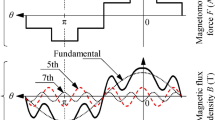Abstract
Discontinuous armature permanent magnet linear motors (DAPMLMs) have recently been proposed to address problems such as the increase of material costs and maintenance fees. However, because of their discontinuous arrangement, the end edge of the armature produces considerable detent forces, which act as a thrust force ripple during operations, resulting in diminished control performance and causing vibration and noise in the machine. Therefore, in this paper, we propose a novel structure of stair-shaped auxiliary teeth applied on the armature end edge of DAPMLMs with concentrated winding, to reduce the end edge detent force generated by the armature discontinuous arrangement. Taguchi’s design of experiment (DOE) method is used for the optimum design of the stair-shaped auxiliary teeth. The experiment deign models are drawn from the orthogonal array of design parameters. Moreover, we analyze the influence of the design parameters on the objective function via 2-D finite element analysis, and verify the validity of the proposed stair-shaped auxiliary teeth by applying the optimum design values obtained via signal-to-noise ratio (S/N ratio) analysis.
Similar content being viewed by others
References
Yoshimura, T., Kim, H., Watada, M., Torii, S., and Ebihara, D., “Analysis of the Reduction of Detent Force in a Permanent Magnet Linear Synchronous Motor,” IEEE Transactions on Magnetics, Vol. 31, No. 6, pp. 3728–3730, 1995.
Hwang, C.-C., Li, P.-L., and Liu, C.-T., “Optimal Design of a Permanent Magnet Linear Synchronous Motor with Low Cogging Force,” IEEE Transactions on Magnetics, Vol. 48, No. 2, pp. 1039–1042, 2012.
Jung, I.-S., Yoon, S.-B., Shim, J.-H., and Hyun, D.-s., “Analysis of Forces in a Short Primary Type and a Short Secondary Type Permanent Magnet Linear Synchronous Motor,” IEEE Transactions on Energy Conversion, Vol. 14, No. 4, pp. 1265–1270, 1999.
Lim, K.-C., Woo, J.-K., Kang, G.-H., Hong, J.-P., and Kim, G.-T., “Detent Force Minimization Techniques in Permanent Magnet Linear Synchronous Motors,” IEEE Transactions on Magnetics, Vol. 38, No. 2, pp. 1157–1160, 2002.
Hall, D., Kapinski, J., Krefta, M., and Christianson, O., “Transient Electromechanical Modeling for Short Secondary Linear Induction Machines,” IEEE Transactions on Energy Conversion, Vol. 23, No. 3, pp. 789–795, 2008.
Omekanda, A. M., “Robust Torque and Torque-Per-Inertia Optimization of a Switched Reluctance Motor Using the Taguchi Methods,” IEEE Transactions on Industry Applications, Vol. 42, No. 2, pp. 473–478, 2006.
Brisset, S., Gillon, F., Vivier, S., and Brochet, P., “Optimization with Experimental Design: An Approach Using Taguchi's Methodology and Finite Element Simulations,” IEEE Transactions on Magnetics, Vol. 37, No. 5, pp. 3530–3533, 2001.
Hwang, C.-C., Lyu, L.-Y., Liu, C.-T., and Li, P.-L., “Optimal Design of an SPM Motor Using Genetic Algorithms and Taguchi Method,” IEEE Transactions on Magnetics, Vol. 44, No. 11, pp. 4325–4328, 2008.
Kim, S.-I., Lee, J.-Y., Kim, Y.-K., Hong, J.-P., Hur, Y., and Jung, Y.-H., “Optimization for Reduction of Torque Ripple in Interior Permanent Magnet Motor by Using the Taguchi Method,” IEEE Transactions on Magnetics, Vol. 41, No. 5, pp. 1796–1799, 2005.
Wang, H. T., Liu, Z. J., Chen, S. X., and Yang, J. P., “Application of Taguchi Method to Robust Design of BLDC Motor Performance,” IEEE Transactions on Magnetics, Vol. 35, No. 5, pp. 3700–3702, 1999.
Awada, A., Wegmann, B., Viering, I., and Klein, A., “Optimizing the Radio Network Parameters of the Long Term Evolution System Using Taguchi's Method,” IEEE Transactions on Vehicular Technology, Vol. 60, No. 8, pp. 3825–3839, 2011.
Hwang, C.-C., Chang, C.-M., and Liu, C.-T., “A Fuzzy-Based Taguchi Method for Multiobjective Design of PM Motors,” IEEE Transactions on Magnetics, Vol. 49, No. 5, pp. 2153–2156, 2013.
Author information
Authors and Affiliations
Corresponding author
Rights and permissions
About this article
Cite this article
Kim, SJ., Park, EJ., Jung, SY. et al. Optimum design of end edge in discontinuous armature permanent magnet linear motors for automation transportation systems. Int. J. Precis. Eng. Manuf. 18, 317–323 (2017). https://doi.org/10.1007/s12541-017-0039-y
Received:
Revised:
Accepted:
Published:
Issue Date:
DOI: https://doi.org/10.1007/s12541-017-0039-y




